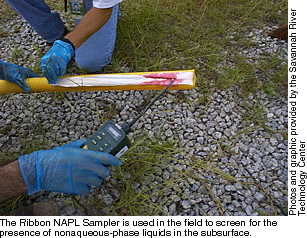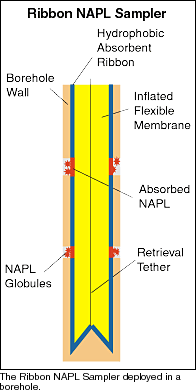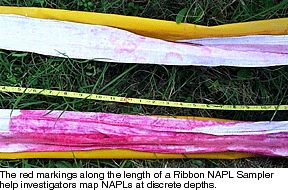
In addition to providing immediate field results, sections of the ribbon can also be sent for laboratory analysis to identify specific NAPL compounds. Using the sampler for initial characterization provides a detailed vertical profile of NAPLs and helps optimize subsequent drilling and sampling. It is relatively inexpensive, reusable, lightweight, and easily transported. As compared to conventional soil and liquid sampling, this small-scale, direct sampling technique produces less investigation-derived waste. Reliance on laboratory analysis results in numerous, costly samples that, because they are considered waste, must be disposed of in accordance with applicable environmental regulations. In FY99, the Ribbon NAPL Sampler was deployed more than 10 times at both DOE and non-DOE sites, including deployments at
Based on data the sampler provided during its deployments into the vadose zone at the
Savannah Anything else available?
The simultaneous deployment of two or more of these or other DNAPL characterization technologies with cone penetrometer drilling is being investigated to accelerate cleanup schedules and milestones. (OST/TMS ID 237) Laser-Induced Fluorescence (LIF) Probe is a sensor for delineating contaminants that fluoresce. Although DNAPLs do not fluoresce at standard excitation wavelengths, organic matter (oils) that are usually found with solvents (DNAPLs) do fluoresce, and their fluorescence is used to infer the presence of DNAPLs. LIF systems, available from commercial and government cone penetrometer drilling operators, are best for source zone characterization since they are sensitive to only very high DNAPL concentrations. (OST/TMS ID 2237) Precision Injection/Extraction (PIX) Probe delivers small amounts of alcohol to the subsurface to solubilize any DNAPL present. The two-step process consists of an injection/extraction of water followed by an injection/extraction of alcohol and a tracer. The presence of a DNAPL source is indicated by a dramatic increase in DNAPL concentration in the extraction from the second step, which contains any DNAPL source freed from pore spaces by the alcohol. The tracer verifies that all injected fluids have been removed. (OST/TMS ID 2239) Membrane Interface Probe System (MIPS) is commercially available from GeoProbe Systems for the quick, depth-discrete detection and quantification of high concentration, dissolved volatile organic compounds (VOCs). Deployed with a cone penetrometer, MIPS incorporates a heated, semipermeable membrane into the cone penetrometer tip. VOCs diffuse through the membrane into a carrier gas, which circulates through tubing to analytical instruments at the surface. Once the MIPS probe is retracted, the hole can be grouted through the cone penetrometer rod itself. Although MIPS’s detection limit is not as low as that with baseline drilling, sampling, and laboratory analysis, it offers significant time and cost savings when data quality objectives can be met. (OST/TMS ID 2950) Although DNAPLs pose a big barrier to the successful cleanup of soil and groundwater at many sites, federal agencies and private industry are working together to test and adapt technologies and document successful outcomes. The more DNAPL characterization and monitoring technologies are developed and refined, the greater the likelihood of developing a successful strategy for using multiple, complementary tools to tackle difficult characterization problems. For more information on the use of the Ribbon NAPL Sampler, contact Brian Riha at the
Savannah River Technology Center at (803) 557-7807, brian.riha@srs.gov. |


 The sampler consists of a
dye-impregnated ribbon inside a reusable inflatable liner. When deployed into an existing
borehole, the sampler is turned inside out and inflated so that the ribbon maintains
contact with the borehole walls. The sampler indicates the presence of NAPLs by turning
red at those depths along the borehole length where NAPLs reside. During removal, a
retrieval tether turns the sampler inside in again as the end of the sampler deepest in
the ground leads the sampler out through the borehole. This removal technique prevents
smearing and preserves the ribbon’s distinctive red markings, which indicate the
presence of NAPLs at discrete depths. The sampler is easily deployed into open boreholes.
Using the sampler to characterize in collapsing sediments or the saturated zone requires a
more complex installation accomplished with a cone penetrometer or other drilling
techniques.
The sampler consists of a
dye-impregnated ribbon inside a reusable inflatable liner. When deployed into an existing
borehole, the sampler is turned inside out and inflated so that the ribbon maintains
contact with the borehole walls. The sampler indicates the presence of NAPLs by turning
red at those depths along the borehole length where NAPLs reside. During removal, a
retrieval tether turns the sampler inside in again as the end of the sampler deepest in
the ground leads the sampler out through the borehole. This removal technique prevents
smearing and preserves the ribbon’s distinctive red markings, which indicate the
presence of NAPLs at discrete depths. The sampler is easily deployed into open boreholes.
Using the sampler to characterize in collapsing sediments or the saturated zone requires a
more complex installation accomplished with a cone penetrometer or other drilling
techniques. River Site, site
personnel have installed additional remediation wells at the A-014 Outfall to address a
small DNAPL layer that was not being treated by the existing soil vapor extraction system.
The additional wells are targeting cleanup of this newly identified zone. Brian Riha, a
principal investigator with the Savannah River Technology Center, is optimistic about the
positive effects this characterization technology can have on cleanup. Riha says,
“The Ribbon NAPL Sampler is a robust method for determining or verifying the presence
and location of NAPL in the subsurface. The identification of NAPLs allows remediation to
be directed at the source and will ultimately reduce the time and cost of cleanup.”
River Site, site
personnel have installed additional remediation wells at the A-014 Outfall to address a
small DNAPL layer that was not being treated by the existing soil vapor extraction system.
The additional wells are targeting cleanup of this newly identified zone. Brian Riha, a
principal investigator with the Savannah River Technology Center, is optimistic about the
positive effects this characterization technology can have on cleanup. Riha says,
“The Ribbon NAPL Sampler is a robust method for determining or verifying the presence
and location of NAPL in the subsurface. The identification of NAPLs allows remediation to
be directed at the source and will ultimately reduce the time and cost of cleanup.”